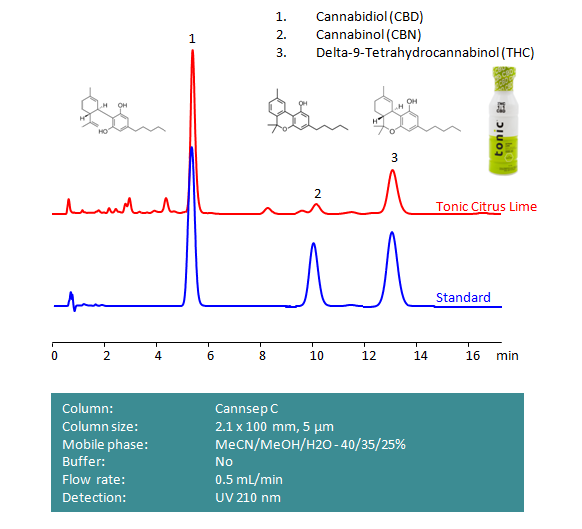HPLC Method for Cannabidiol (CBD), Cannabinol (CBN), Delta-9-Tetrahydrocannabinol (THC) on Cannsep C by SIELC Technologies

High Performance Liquid Chromatography (HPLC) Method for Analysis of CBD, CBN, delta-9 THC, delta-8 THC
Cannabidiol (CBD), cannabinol (CBN), and delta-9-Tetrahydrocannabinol (THC) are three of the most active cannabinoids in cannabis.
Delta-9-Tetrahydrocannabinol, also known as delta-9-THC and Δ9-THC, or simply THC, is the principal psychoactive constituent of Cannabis with the chemical formula C21H30O2. In pharmaceutical contexts, it is referred to as dronabinol and is used un nabiximols, which helps alleviate neuropathic pain, spasticity, overactive bladder, and more. Medical use of THC is allowed in the majority of the states in the United States of America, with less than half having it be legal for recreational use.
Cannabidiol (CBD) is a phytocannabinoid with the chemical formula C21H30O2. It is used in a variety of ways. It’s only confirmed medical use is as epilepsy medication. It may help with pain, sleep, and addiction as an alternative to opioids, but due to limited clinical evidence, it’s regulations are dependent on the state. It is advised against using it during pregnancy due to unknown effects on fetal and infant development.
Cannabinol (CBN) is a mildly psychoactive phytocannabinoid with the chemical formula C21H26O2. It was the first cannabinoid to be isolated from cannabis in the late 1800s. It is legal in the United States as long as the THC concentration is 0.3% or less. Little research has been done into it’s potential health benefits.
These cannabinoids can be detected in the low UV regime. Using a Cannsep C reverse-phase column and a mobile phase consisting of water, methanol (MeOH) and acetonitrile (MeCN) with a sulfuric acid (H2SO4) buffer, CBD, CBN, and THC can be separated, measured, and analyzed. This analysis method can be UV detected at 210 nm with high resolution, even in real-world samples.
| Column | Cannsep C, 2.1 x 100 mm, 5 µm, 100 A, dual ended |
| Mobile Phase | MeCN/MeOH/H2O – 40/35/25% |
| Buffer | No |
| Flow Rate | 0.5 ml/min |
| Detection | UV, 210 nm |
| Class of Compounds | Drug, Hydrophilic, Ionizable, Supplements |
| Analyzing Compounds | Cannabidiol (CBD), Cannabinol (CBN), Delta-9-Tetrahydrocannabinol (THC) |
Application Column
Cannsep C
Column Diameter: 2.1 mm
Column Length: 100 mm
Particle Size: 5 µm
Pore Size: 100 A
Column options: dual ended
Cannabinol (CBN)
Delta-9-Tetrahydrocannabinol (THC)





